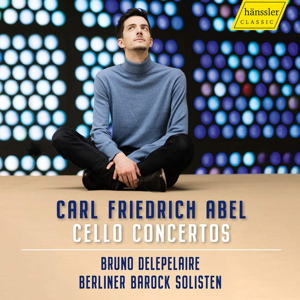
Carl Friedrich Abel (1723-1787)
Cello Concerto No. 2 in C major, WKO 60 (1782)
Sinfonia Concertante No. 1 in B flat major, WKO 42 (1775)
Sinfonia Concertante No. 2 in D major, WKO 43 (1782)
Cello Concerto No. 1 in B flat major, WKO 52 (ca 1756/58)
Bruno Delepelaire (cello)
Christoph Hartmann (oboe)
Berliner Barock Solisten/Kristof Polonek (violin)
rec. 2022, Teldexstudios, Berlin-Lichterfelde, Germany
First recordings: Sinfonias
HÄNSSLER CLASSIC HC22022 [74]
The life of Carl Friedrich Abel straddles the Baroque and Classical eras. Born just after Bach took up his position in Leipzig (Abel’s father succeeded Bach in Köthen) and dying just before Mozart, he lived and worked in a period of considerable change. He was best known during his life as a viola da gamba virtuoso, and as business partner of Johann Christian Bach as the leading concert promoters in London for seventeen years until Bach’s death in 1782.
Following JC Bach’s death, Abel departed London for continental Europe, and it is thought that the two 1782 works were written for presentation to Friedrich Wilhelm, Crown Prince of the Prussian Court in Berlin, and a keen amateur cellist. They are also among the last works that Abel wrote, as the final years of his life were blighted by alcoholism.
What we know of his music, and he certainly hasn’t been ignored in the catalogue – Presto lists 85 recordings which include his music – is mainly that for his own instrument. By the 1750s, the viola da gamba’s star was on the wane – Abel must have been one of its last virtuosos – so it is not surprising that he looked around at related instruments, the most obvious being the cello. The two concertos presented here are his only two, written decades apart. Each has been recorded before, though only once or twice, and this is the first time on the same disc. I haven’t heard the other versions, but we do have a review of the B flat work on a disc released in 2022 (review).
Looking at the two concertos, it should be noted that his first predates Haydn’s first by several years. Unfortunately but hardly surprisingly, it is not ahead in musical quality. It is attractive, stylish, but ultimately unmemorable. The second shows a substantial upgrade in style and substance. No, it still doesn’t approach the level of genius shown in Haydn’s, but no one could reasonably expect it to. Placing the concertos in reverse chronological order, bookending the CD has the advantage of opening the recording with a very fine work, and the disadvantage of closing it with a fairly non-descript one.
The two sinfonias include a significant solo role for the cello, but the main instrument is the oboe. The extra instrumental colour added by the oboe and violin lifts them above the cello concertos in quality and interest. When Classical era Sinfonia Concertantes are mentioned, the obvious one is Mozart’s for violin and viola. Nothing could ever match it, but these two are thoroughly entertaining, with some very high points dotted throughout. The interplay between the solo instruments in the D major’s Adagio is quite beautiful. How they have not managed to receive recordings before now is very surprising.
This is my first encounter with the young French cellist Bruno Delepelaire, and while his presence in the catalogue is not extensive, he is the First Principal Cello of the Berlin Philharmonic, which speaks volumes of the quality of his playing. He was chosen to play the solo in the Elegy by John Williams in the composer’s Berlin Concert (released last year on DG). He has recorded some of CPE Bach’s concertos with the excellent Berliner Barock Solisten – that would seem a very promising combination. Sound is very good, and the booklet notes are excellent.
There is nothing here to challenge the very best in the respective genres, but each work has its charms, and the two Sinfonias are definitely worth repeat listens.
David Barker
Help us financially by purchasing from





















